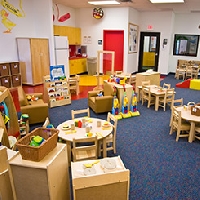
Create a stimulating, comfortable, and effective preschool classroom environment
Designing a preschool classroom with safe, durable, comfortable and age-appropriate preschool furniture and supplies is a critical element of creating an effective and stimulating classroom environment. The layout and design of a preschool classroom can have a significant impact on the learning potential of young children.
There are several things to keep in mind when selecting preschool furniture and supplies for your classroom. Scale is one of the most important considerations when it comes to purchasing preschool furniture and supplies. Do not make children feel small in their learning environment. Chairs, tables and furniture must be child-sized. Shelving for toys and learning materials should be at child level. Containers for toys should be easy-open and child friendly.
Many preschool educators recommend dividing a classroom into separate centers, activity areas or work centers. These unique learning areas allow children the freedom to explore specific areas of interest, while spreading out to circulate through a classroom based on a school day time schedule.
Some traditional recommendations for preschool activity areas include: a science center with a sand or water table, a home center, with child-sized play toys such as a wooden kitchen and pretend food, a dress-up center with clothing, costumes or even puppets for dramatic play, a building center with blocks or legos, a library or listening center with books and recordings, a music center with instruments such as maracas, drums, xylophones etc, and an art center with a table for coloring or paintings and manipulatives such as clay or play dough, and a physical activity area with gymnastic mats, slides, and riding or rocking toys.
In addition to activity centers within a classroom, many preschools may also offer outdoor playground space, and a separate room for rest time or nap time. Playground equipment as well as rest time cots, mats, sheets and blankets are also key considerations for educators or schools purchasing preschool furniture and supplies.
When designing a preschool classroom and locating indoor activity centers, it is important to consider the architectural elements, proportions and layout of a space. Preschool educators may wish to begin by sketching out or experimenting with various activity center layouts.
Ideally, art areas and sensory tables should be positioned near a sink. Science areas are best placed near a window, for access to sunlight. Louder areas such as music areas and blocks should be kept toward the rear of the room. You may wish to separate these areas with room dividers or shelving systems that act as buffers to reduce the level of noise. Quiet listening or library areas should be placed farthest away from the louder centers.
Once the layout of a classroom has been configured, it is time to select unique preschool furniture and supplies for each distinct activity center.
Bean bag chairs or cozy upholstered furniture are best suited for the quiet reading or listening areas, while a sturdy, child size table and chairs are ideal for the art center. Benches or social seating may be more appropriate for dress up or dramatic play areas. Cubbies are one example of child size shelving systems for art supplies, musical instruments, etc. Plastic bins and open baskets are suitable containers for other toys or educational materials. When selecting preschool furniture and supplies, keep in mind that plastic or vinyl surfaces that are easy to clean and sanitize are ideal.
Ultimately, careful consideration should be given to the design, comfort and function of a preschool classroom, as preschoolers may spend as much as eight hours a day in the environment. An organized, effective preschool classroom can inspire active, engaged and meaningful learning.

